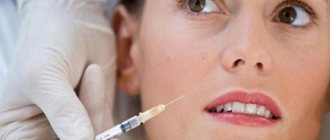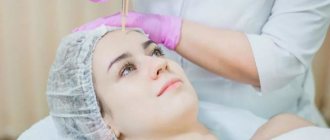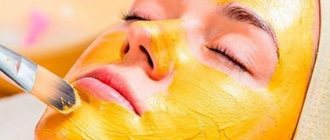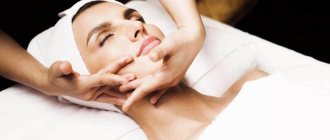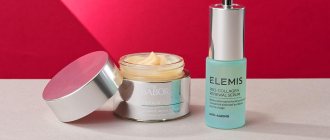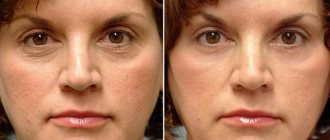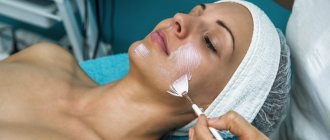- 15837
- 09-10-2020
- Author: Mysekret Team
- 0
As a person reaches a certain age (“critical point” - from 30 years and older), the amount of fibrillar proteins responsible for skin turgor, known as collagen and elastin, naturally decreases. This is expressed in a decrease in skin elasticity, loss of freshness and a healthy natural tone. Facial features also change: the oval becomes wider, the cheekbones and nose stand out more sharply. Fortunately, modern cosmetology has innovative technologies that can slow down the irreversible aging process.
The essence of peeling and biorevitalization
Before identifying the essence of both procedures, it is necessary to understand what goals each of them pursues. The end result, as a rule, is the desire to achieve improvement and noticeable rejuvenation of the facial skin. Modern cosmetology has several techniques used to solve such problems.
One of these methods includes biorevitalization . The complex term hides the well-known injections of hyaluronic acid (hyaluronate). The essence of the technique is to saturate the deep layers of the dermis and epidermis with non-sulfonated glycosaminoglycan, which is part of connective, epithelial and nervous tissues. Transportation of hyaluronate components together with vitamin complexes is carried out through injection or laser implementation of a special gel.
See also...
✅ Facial biorevitalization: description of the procedure, advantages and disadvantages
✅ Facial soda: mask, peeling, scrub
✅ Facial peeling roller: rating of the best!
✅ How often can you do facial biorevitalization?
The beneficial properties of hyaluronic acid include the following:
- Stimulation of regeneration processes in the dermis and epidermis;
- Activation of the natural production of elastin and collagen;
- Reduced activity of the sebaceous glands;
- Smoothing out small wrinkles;
- Normalizing metabolic processes in skin tissues.
To make the effect of the biorevitalization procedure last longer, a course of several injections of the drug is usually prescribed. The duration of the course is determined by a cosmetologist based on the condition of the patient’s skin, her age and body characteristics.
Step by step biorevitalization looks like this:
- The cosmetologist thoroughly cleanses the client’s face using one of the available methods;
- An anesthetic cream is applied to the facial skin for 20 - 30 minutes. This will help reduce pain during injection of the drug into the skin tissue;
- The drug is injected under the skin with a thin needle or using low-intensity laser radiation. The first technique is considered more effective, but it is also more painful.
Often, patients after injection biorevitalization complain of the appearance of hematomas and small swellings on the face (papules). But this is a completely common phenomenon that will go away on its own over the next 1 to 2 days.
Unlike biorevitalization, during deep cleansing of the facial skin, which is peeling , the transport of substances into the tissues of the epidermis and dermis does not occur. Instead, the cosmetologist removes dead epithelial cells chemically or mechanically. In other words, peeling is a forced “launch” of natural metabolic processes in the skin by exposing young and healthy cells. Thanks to this, cellular respiration is stimulated, and beneficial substances enter the skin tissue faster and more actively.
For deep cleansing of the skin, special high-concentration acid preparations are used, the use of which should only be carried out by a specialist. It is not recommended to perform the procedure at home, as this can result in damage to the epithelium and the appearance of burns.
Another popular option is the retinoic or "yellow" peel . It involves exposing the skin to retinoids - artificial analogues of vitamin A. This facial cleansing technology is more gentle: with it, concentrated retinoic acid (tretinoin 5% or 10%) is applied to the skin for a quarter of an hour, as a result of which an occlusive layer is formed on it and, in During this process, the uniform production of tretinoin is stimulated. Typically, a course of “yellow” peeling includes at least four procedures, repeated at intervals of 2 to 4 weeks.
Peeling after biorevitalization
Peeling after biorevitalization is not only useful, but in certain cases it is extremely important. Whether it is needed before hyaluronic acid injections is determined by a cosmetologist. Experts recommend doing biorevitalization first in the following cases:
- if the skin is in poor condition due to bad habits, hypovitaminosis, unfavorable climatic conditions;
- if both procedures are done for the first time (the skin must get used to it);
- if deep or medium cleansing is carried out (hyaluronic acid smoothes the surface of the skin, making the acids act more smoothly);
- if dry cleaning is done (swelling after aggressive drugs is weakened);
- if the aging process is pronounced, pigmentation appears.
If there are no complications after biorevitalization, peeling can be done only after 2 weeks. But the duration of the pause in each specific case is determined by the composition (liquid or ether) of the biorevitalizant. The pause between hyaluronic injections should also be at least 2 weeks.
Is it possible to combine?
Biorevitalization has its own characteristics, as does the procedure for deep skin cleansing, and the indications for them are different. Thus, facial peeling is carried out even for adolescents under the age of 18, since it is during puberty that they encounter dermatological problems such as rosacea, acne, acne and increased oily skin. But injections of hyaluronic acid are not indicated for persons under 30 - 35 years old , unless there are special indications for their use.
Most often, when asked whether it is worth combining biorevitalization and peeling, cosmetologists give a negative answer . The impact on the skin during both procedures is quite traumatic and requires some time for natural regeneration. Therefore, if in any salon you are offered to combine them in one visit, we advise you to refuse and look for another place for cosmetic treatment.
Intervals between procedures
The intervals between procedures are determined by a specialist:
- 7–14 days should pass between aggressive acid peeling and biorevitalization for the epidermis to recover;
- light retinoic peeling is quite compatible with biorevitalization - it can be done on the 3rd day after invasive intervention;
- atraumatic peelings (scrubs, homemade masks based on fruits) can be done the day before the introduction of hyaluronic acid, after - it is prohibited;
- peeling after biorevitalization is possible after 14–20 days;
- The pause maintained also depends on the concentration of acids for chemical peeling or the consistency of the drug injected under the skin (ether or liquid).
Chemical peeling or biorevitalization is done only on healthy skin. The dermis should not be inflamed or strewn with hematomas. If you neglect this rule, you can significantly harm your skin.
Sequence of procedures
The main question that clients who want to undergo facial skin treatment and rejuvenation ask at an appointment with a cosmetologist is the choice of the sequence of actions.
What is the best course of action: undergo peeling and then agree to hyaluronic acid injections or change the order of procedures. There is no definite answer to this question, since the specialist will make a decision on an individual basis, based on the characteristics of your body and skin condition, as well as other factors (age, the presence of certain diseases, taking certain medications, etc.).
Both procedures differ radically in technology, type of effect on the skin and materials used during the process. This is also necessarily taken into account when choosing the sequence and tactics of action.
Why is this stage critical? It all depends on which skin cleansing technology is chosen: retinoic (“yellow”) or chemical peeling. The second option is more traumatic , and after it is carried out, the facial skin tissues remain swollen for a long time. If you inject hyaluronic acid within the permitted period after chemical peeling, the regeneration process will be accelerated, due to which the swelling will go away a little faster.
The effect is explained by the peculiarities of the action of hyaluronic acid, which adsorbs excess liquid remaining in the epidermal cells after chemical cleansing. However, biorevitalization cannot be carried out immediately: a certain time interval must be maintained.
Retinoic peeling has a gentle effect on the skin, so biorevitalization after it is carried out in a shorter time. Already on the third day, the balance of vitamin A in the treated skin is restored enough to create a reliable effect against aggressive external factors.
Peeling before biorevitalization
If you are advised to cleanse your facial skin before administering hyaluronate injections, please note that one of the effects achieved will be a reduction in the period of regeneration of the epidermis after the use of aggressive acids.
The selected procedure diagram will look like this:
- To begin with, the cosmetologist will perform approximately two deep cleanses with glycol at intervals of 7 to 10 days. Thanks to this procedure, the facial skin will be exfoliated from dead cells, and active collagen synthesis will begin in its deep layers;
- Then intermediate injections of hyaluronate are carried out after 4 - 5 days;
- After another 5–6 days, the patient undergoes two peeling procedures again with an interval of a week;
- Having completed all these steps, it again undergoes final biorevitalization 5 days after the last peeling.
With this scheme, a complex effect is achieved, namely: the skin recovery period is shortened, the patient practically does not abandon the usual rhythm of life, and the result of the procedure is noticeable to the naked eye after 15 days.
Biorevitalization before peeling
The chosen method of facial rejuvenation, in which peeling is carried out step by step after biorevitalization, also has its own characteristics. They include a special sequence, number and order of manipulations:
- Hyaluronic acid injections are carried out in three doses, with an interval of 15 days between each procedure;
- After this stage, the patient undergoes retinoic peeling. Recovery after cleansing and how effectively the process of facial skin restoration proceeds largely depends on the conscientious implementation of medical recommendations (we’ll talk about them below), which are mandatory during the rehabilitation period.
It is believed that biorevitalization carried out before peeling will facilitate the skin regeneration process and reduce the risk of side effects and complications.
Combination
It is strictly forbidden to carry out peeling and biorevitalization at the same time. Both procedures are characterized by a high degree of trauma. Biorevitalization is allowed after peeling only when the rehabilitation period is completed. Otherwise, serious complications cannot be avoided.
Conditions for combining procedures:
- The duration of the pause between sessions is set by the cosmetologist. The skin must recover from the aggressive effects of cleansing agents.
- Biorevitalization after peeling is more desirable. But whatever the combination of procedures, their effectiveness increases almost 2 times with a complex effect.
- With comprehensive care, fewer sessions are required. 2 peeling sessions and 3 biorevitalization sessions are enough, which is beneficial both financially and time-wise.
How long after one procedure to do another is determined by the cosmetologist, focusing on the individual characteristics of the patient’s skin. Typically, experts advise performing it 2 weeks after chemical peeling. And if retinoic acid was used, then after peeling you can do biorevitalization within 4-5 days.
Intervals and restrictions
Many patients try to find out on their own, but any responsible cosmetologist, even before the procedure, is obliged to tell you how many days after peeling you can do biorevitalization.
Of course, this time interval should not be very long, otherwise the effect after deep cleansing of the skin will be minimized. The ideal option is to wait about 10–15 days . If you do biorevitalization earlier, it will give an undesirable result, since the skin tissue at this moment is still quite vulnerable. If an atraumatic skin cleansing technology (for example, retinoic peeling) was chosen, the waiting period can be reduced to a week or even five days.
When undergoing chemical peeling, the interval between procedures should be from a week to 15 days. It is better to wait the maximum recommended time, since regeneration of the epidermis after dry cleaning takes quite a long time. If you undergo hyaluronate injections at an earlier date, erythema may develop.
There are certain restrictions imposed on a patient who has undergone a combination of both procedures. This list includes special recommendations, ignoring which may reduce the effect of injections and deep cleansing of the skin:
- Skin exposed to traumatic effects is prone to hyperpigmentation, so before going outside, you should apply protective products with a high SPF factor to your face. This measure must be observed for a month after the procedures, but for skin health it is better to protect it from the negative effects of ultraviolet rays on an ongoing basis. You must refrain from visiting the solarium for at least 15 days;
- While the skin is recovering after visiting a cosmetologist, do not use harsh peels and scrubs, face masks and creams. In order not to provoke the development of a spontaneous allergic reaction, do not try new beauty products and cosmetics for a month;
- Keep antihistamines in your home medicine cabinet at all times. This is a necessary measure for everyone, not just those who are prone to allergies. If, during the recovery period, rashes, erythema and swelling appear on the facial skin due to an allergic reaction, this may negatively affect its condition and negate the effect of peeling and biorevitalization;
- For a week after the procedure, do not expose yourself to physical activity (especially weights). Increased physical activity contributes to a rush of blood to the skin of the face, and this is undesirable;
- For 2–4 weeks, any additional cosmetic and/or plastic correction interventions on the facial skin are prohibited;
- In the first weeks after the procedures, avoid visiting the bathhouse and sauna;
- During the recovery period, stop taking B vitamins.
Features of the procedures
It should be noted that peeling and biorevitalization are two completely different techniques in terms of their effects. But both of them have a rejuvenating effect on the skin. After them:
- the functioning of the sebaceous glands is normalized, oily sheen and flaking go away;
- Pores are cleaned, which means the dermis is better enriched with oxygen;
- the production of own collagen is carried out, which leads to the minimization of wrinkles;
- the skin becomes smooth and acquires an even color;
- a lifting effect is provided.
Thus, not only does the skin cleanse, but it also prevents the effects of negative environmental factors and the aging of the body.
By the age of 30, almost every woman begins to develop wrinkles. This process is associated with a slower metabolism and reduced production of collagen and elastane. Turgor is lost, the skin becomes uneven and acquires a grayish tint, unevenness is noticeable, and the oval of the face becomes blurred. But thanks to the miraculous procedures of peeling and biorevitalization, the production of collagen fibers is activated. The procedure is indicated after 28 years.
The essence of peeling
The essence of peeling is that the skin is freed from various types of contaminants - dust, remnants of decorative cosmetics, keratinized scales of the epidermis and subcutaneous fat, called sebum in medical circles. Injection of drugs into the deep layers of the epidermis is not required. By eliminating everything that prevented the dermis from breathing normally, metabolic processes are launched and the skin becomes young.
As you know, the epidermis consists of several layers. On average, on day 28, the top layer peels off. But due to age-related changes, this process slows down. The remaining particles prevent the supply of nutrients, water and oxygen to the skin, and it loses its former beauty. To avoid this, you should cleanse your face from time to time.
Chemical peeling is stressful for your skin. But thanks to the destructive effect of acid on keratinized scales, new (young) cells after the resulting shake-up become more resistant to destructive environmental factors.
With the help of chemical peels, the upper or middle layer of the epidermis is burned out. This shake-up for the body triggers the production of collagen and elastane fibers, and also promotes accelerated regeneration of the skin.
Advice. It is advisable to carry out chemical peels in an office setting, because the specialist will always feel the moment when it is necessary to neutralize the acid, so as not to provoke a severe burn and other side effects.
There are the following peeling options:
- using acids - lactic, glycolic, grape, salicylic, trichloroacetic and many others;
- using special devices - laser, ultrasound, etc.;
- carrying out scrubbing;
- use of fruit-based acid cleansing masks.
Chemical peels with highly concentrated acid are done only in the salon. In terms of savings, it is also advantageous to carry out hardware procedures in a cosmetologist’s office. But you can easily try weakly concentrated acid peels, scrubbing and applying masks at home.
The essence of biorevitalization
Biorevitalization is a popular innovative cosmetic procedure that involves introducing hyaluronic acid into the deep layers of the epidermis in an invasive way, that is, using a syringe. A special gel of animal origin penetrates the skin, fills voids and is not rejected by the epidermis. It promotes:
- improved hydration (you will notice how the dermis has become smoother without peeling);
- production of its own hormone by the epidermis;
- lifting effect - the skin becomes tightened and elastic;
- normalization of metabolic processes and saturation of the skin with vitamins and minerals;
- beautiful smooth peach color.
There are also creams with hyaluronic acid, but their ability to penetrate deeply into the layers of the epidermis is much lower than when using injections. In addition, if you want to achieve a truly amazing effect, cheap cosmetics are unlikely to contribute to this - for a good 30 ml cream you will have to pay 4-5 thousand rubles. An ampoule of gel with hyaluronic acid will cost 7–11 thousand rubles, depending on the brand of the manufacturer.
To get a positive and lasting result, you need to take a course involving several sessions of introducing hyaluronic acid. The number of visits to a cosmetologist’s office is determined by a specialist in each specific case, taking into account the condition of the skin. It is enough to take 2 courses to stay young.
Which sequence is better to choose?
The optimal alternation of facial cleansing and biorevitalization procedures is the one that suits you personally. Each patient has his own characteristics of the body; there are no general recommendations. There is an opinion that the correct sequence of procedures should be determined after at least two consultations with an experienced cosmetologist. The specialist will not only select techniques for your specific case, but will also set the necessary time frames between each stage.
That is why you should not expect a definite answer to the question of what is better – peeling or biorevitalization. Both procedures have different effects on the skin of the face, so it is incorrect to look for their advantages and disadvantages in comparison with one another.
When preparing the material, consultation was carried out by:
Olga Kirilova (cosmetologist). A specialist with higher medical education and extensive work experience. Helped hundreds of patients cope with various skin problems. Conducts non-hardware and hardware procedures. Proficient in laser and phototherapy techniques.
Share with your friends!
more
Read us in the Zen channel
Choosing the right sequence
Peeling or biorevitalization? Experts in the world of cosmetology are confident that you can combine both procedures, expecting a double effect. That is why they recommend not just giving preference to any one effect, but resorting to an integrated approach that involves cleaning pores, improving epidermal regeneration and introducing collagen.
What to do first - peeling or biorevitalization? The answer is obvious - it all depends on the individual characteristics of each organism.
It should be noted that when using aggressive, highly concentrated acids, peeling is first done, and then invasive intervention is used. Yellow (retinoic) peeling is also possible after biorevitalization, but to achieve a positive effect you will need to inject hyaluronic acid several times under the skin.
Peeling before biorevitalization:
- prolongs rejuvenation for up to 1 year;
- will provide a pronounced moisturizing effect;
- will make the oval clear and the skin tightened;
- eliminates scars and age spots;
- will provide additional smoothing of wrinkles.
Interesting point: Retinoic peeling accumulates under the skin 3 days after the procedure, protecting the dermis from the harmful effects of the external environment. But such a positive effect is not endless, so you need to periodically administer vitamin A after the combined course.
After peeling, the patient may experience severe swelling. Hyaluronic acid absorbs all excess moisture, minimizing swelling and speeding up the recovery period.
Some cosmetologists, on the contrary, first do biorevitalization, and then medium or deep chemical cleansing of the face. This sequence is relevant:
- if you have bad habits;
- when a change in climatic conditions is planned;
- the patient has an unbalanced diet;
- serious age-related changes on the face - drooping of the upper eyelid, hyperpigmentation is observed, increased relief and deep expression wrinkles are formed;
- with further laser resurfacing;
- when chemical peeling will be done for the first time (for preparation purposes).
As you can see, the procedures can be swapped depending on the expected effect.
Restrictions
Cosmetologists unanimously declare that peeling and injecting hyaluronic acid in one visit to a cosmetologist is prohibited. To achieve maximum effect, adhere to the following rules:
- protect your dermis with sunscreen and stay in the sun as little as possible;
- minimize physical activity;
- try not to touch your face on the first day in order to reduce the risk of introducing bacteria;
- sauna, facial massage and bath are prohibited in the first 7 days;
- on the first day after the procedures, do not wash your face or use decorative cosmetics;
- For better healing of the dermis, use pharmaceutical ointments prescribed by a cosmetologist.
Thus, given the difference in methods and effects on the epidermis, it is impossible to answer which is better - peeling or biorevitalization. Both techniques are aimed at rejuvenating and stimulating the regeneration of the epidermis.
It is important that, taking into account the characteristics of your body and the problem that has arisen, they are carried out at certain intervals - when the skin recovers from stress after the procedure. Peeling can be carried out both before and after biorevitalization. Weak acid peels (retinoic and almond) can even be combined with the introduction of hyaluronic acid.
DSA peelings and REPART® biorevitalizants - an effective comprehensive approach to skin rejuvenation
Author: Shai Artem Mikhailovich Ph.D., dermatovenerologist, cosmetologist, anatomist, Moscow
Abstract
Age-related changes in the skin occur in all its layers, therefore, for effective prevention and correction of signs of aging, it is necessary to simultaneously work with both the epidermis and dermis. For this purpose, different methods are combined in cosmetology protocols and programs. One of the most effective combinations is peeling and biorevitalization. This article presents new means for carrying out these procedures, distinguished by the originality of their composition and action.
Keywords
skin, peeling, DSA, biorevitalization, REPART®, ammonium trichloroacetate, hyaluronic acid
Briefly about the features of aging of different layers of the skin, associated clinical signs and methods for their correction
Like the entire human body, the skin undergoes a number of significant changes with age. And although its age-related changes are associated with the general aging process, determined genetically, they are also mediated by the aggressive effects of environmental factors, among which the most destructive is UV radiation [1].
Dermal layer
According to a study by Austrian scientists Rosvita Sgonk and Johann Gruber, presented in the journal Gerontology in 2013, with age, the mitochondrial function of fibroblasts is inhibited, which interferes with the normal functioning of these cells, including a decrease in their synthetic activity. As a result, the quality of the dermal matrix deteriorates—the structure and organization of collagen-elastin fibers are disrupted, and the level of hyaluronic acid decreases [2–4].
Clinical signs of such changes will be sagging (atony), loss of elasticity, deep wrinkles, sagging (ptosis).
The most effective and physiological method of preventing and correcting signs of dermal aging is biorevitalization - intradermal injection of native high-molecular hyaluronic acid (HA). Its mechanism of action is as follows: in the skin, exogenous HA is quickly destroyed into individual small fragments, which serve as signals for fibroblasts to synthesize their own HA. A course of biorevitalization procedures will allow you to reach a level at which the HA content in the dermal layer will correspond to younger skin. This level can then be maintained with periodic procedures.
Epidermis
With age, the rate of epidermal renewal decreases. And this is not only the result of the implementation of the genetic program, but also a consequence of the deterioration of microcirculation. The epidermis has no blood vessels and receives its nutrition from the dermal layer. If the timely supply of nutrients, regulatory and other substances is disrupted, then basal keratinocytes find themselves in conditions of deficiency of the substrate necessary for normal functioning, and their vital activity is inhibited.
Clinical signs of disturbances in the process of renewal and keratinization of the epidermis are numerous fine wrinkles, dull and uneven skin tone, rough rough texture - all these are characteristic signs of age-related changes, reflecting structural changes at the level of the epidermis [5]. There is one more feature: when the rate of division and migration of keratinocytes slows down, the epithelization of the skin worsens, and this must be remembered when using chemical peels [6, 7].
Chemical peeling is considered the most effective and safe way to exfoliate and activate the rate of epidermal renewal. There is a wide variety of peeling preparations on the market, differing in mechanism and depth of action. All of them, with the exception of retinol peeling, somehow damage the stratum corneum and barrier structures of the skin upon contact with the skin. This damage triggers the activation of mitosis of basal keratinocytes and their migration to repair the damage.
Work on finding new substances and improving formulations for topical and injection effects on the skin does not stop, and interesting products appear on the market every year. We present two such new products - DSA Deep Skin Art peelings and REPART® biorevitalizants, developed by Russian specialists on their own scientific and technical base.
DSA Deep Skin Art peelings based on ammonium trichloroacetate
Trichloroacetic acid (TCA) has a long history of use in dermatological practice as a peeling agent. Its action is to break the disulfide bonds of proteins that it encounters on its way. In the stratum corneum these are protein corneodesmosomes, keratin and proteolytic enzymes, in the living layers of the skin - protein receptors on cell membranes, extracellular proteins and enzymes. TCA is highly toxic and irreversibly damages proteins. It easily penetrates the stratum corneum, can reach the dermis and even enter the bloodstream. And although there are ways to control its penetration (this is the appearance of a frost consisting of coagulated proteins, or a special color indicator added to the compositions), the TCA peel procedure remains risky, painful and requires a long recovery period. Patients had to take risks and endure the severe pain that occurs when TCA gets into the skin. Before the era of injection cosmetology and the advent of new hardware technologies, there were essentially no other ways to reach the deep layers of the skin in order to initiate structural changes in them. Today we have excellent effective and safe alternatives, so classic TCA peeling has become less and less used.
However, it turned out to be too early to erase TCA from the arsenal of cosmetological methods. This substance has returned, but in a modified form. Several years ago, a drug appeared on the market in which TCA was not present in a free state, but in combination with urea peroxide. As part of such a complex, TCA is neutralized and does not destroy proteins. The complex is relatively stable, and its breakdown releases TCA, urea and peroxide, which quickly decomposes to water and oxygen. Most of the complexes disintegrate in the dermal layer, where the following occurs: TCA nonselectively denatures protein structures, incl. “old” fibers, making them available for destruction by metalloproteinases and subsequent replacement by new fibers, and oxygen intensifies cellular respiration and synthetic activity of fibroblasts.
| Table. 1. Composition, indications, clinical results and recommendations for the use of DSA Deep Skin Art peelings | |
Peeling DSA pH 2.3Active Ingredients
| Peeling DSA black pH 2.3Active Ingredients
|
Indications:
| Indications
|
Action
| Action
|
Well: 4–6 procedures, once every 7–10 days Procedure time: 45 min (including mask exposure) Bottle volume: 5 ml 1 bottle is designed for at least 2 procedures. Drug consumption:
| |
This interesting technology has been further developed in the peelings of the DSA Deep Skin Art line, which include a complex of ammonium salt TCA (ammonium trichloroacetate) with peroxide. This complex is more stable and, compared to the TCA/urea peroxide complex, does not hydrolyze as quickly, which, on the one hand, increases safety due to the slower release of TCA, and on the other, prolongs the action of the substance in the skin.
DSA Deep Skin Art peelings contain kojic acid (5%) - it reduces the production of melanin and significantly lightens age spots and prevents the appearance of new ones. DSA black peeling also contains black activated bamboo charcoal, which has absorbent and bactericidal properties. It is able to draw out and absorb microparticles of pollution, excess sebum, microorganisms and metabolic products from the surface of the skin (Table 1).
Essentially, by using a modified TCA peel, we induce chemical remodeling of the dermis without trauma. A small part of TCA, which was released earlier in the epidermis, is enough to stimulate the division and migration of keratinocytes of the basal layer. Therefore, a few days after the procedure, slight peeling may be observed, which can be easily corrected with a moisturizer. Immediately after the procedure, the patient will notice an increase in turgor, straightening of fine wrinkles and a slight blush that gives freshness. This is due to the reaction of skin vessels - they expand, providing blood flow to the treatment site. This effect can last for several days and is very popular with patients.
Thus, DSA Deep Skin Art peels managed to preserve the beneficial properties of TCA and minimize risks and injuries. These peels do not require a recovery period, and procedures can be performed year-round. They can be recommended as an express “get out” procedure, and in addition, they are ideal for preparing the skin for aggressive aesthetic procedures, prolonging and enhancing the effect of injection and hardware procedures.
Biorevitalizants REPART®
The REPART® product line (Table 2) are biorevitalizant gels for intradermal administration based on the sodium salt of native high-molecular hyaluronic acid of biotechnological origin. Pharmaceutical quality raw materials are used for their production, production complies with EU GMP standards.
The remodeling effect of biorevitalizants is associated with the signaling effect of HA fragments formed as a result of enzymatic biodegradation of high molecular weight HA on fibroblasts. In response, fibroblasts begin to synthesize their own HA, as a result the turgor of the skin tissue increases, the skin tightens, and wrinkles are smoothed out.
Repart ® 4 Aqua Balance: the concentration of sodium hyaluronate is close to the physiological one, characteristic of the intercellular substance of the dermis, which promotes uniform distribution of the drug in the tissue and rapid achievement of the effect, as well as a reduction in the rehabilitation period associated with contouring of papules. This is due to the combination of two fractions of HA of different molecular weights: HA 1.2 million Da provides an instant effect of radiance and plumpness of the skin; HA 2.5 million Da promotes prolonged biorevitalization. The clinical results of using the drug are: increasing the hydro reserve and hydration of the dermis and, as a result, smoothing wrinkles, increasing elasticity, tone and improving skin color. The target patients for the use of this drug are young and middle-aged patients who need preventive and corrective anti-aging measures.
Repart ® 5 Active: the concentration of sodium hyaluronate is selected to create a lifting and firming effect on the skin. Provides reliable results in smoothing fine and medium-deep wrinkles and reduces skin flaps. Indicated for middle-aged and elderly patients with manifestations of dermatoatrophy, severe and persistent dryness, with thin skin and a finely wrinkled morphotype.
Repart ® 6 Delicate: the concentration of hyaluronate is within the optimal physiological range. This allows the drug to be instantly distributed in the tissues and not be contoured in the form of tubercles. Provides rapid hydration and improvement of skin color, helps prevent age-related changes in the dermis caused by both chronological processes and those provoked by external factors. Indicated for young patients, when working with delicate areas, patients with a deformational morphotype and those prone to edema.
Repart ® 7 Ultimate: the product has a denser texture. This is due to the combination of hyaluronic acid and mannitol. Thanks to mannitol, the moisture-holding properties of the drug are increased and the time of biofermentation of hyaluronic acid in the dermis is slowed down, which ultimately provides a prolonged effect of moisturizing and revitalizing the skin. Mannitol also has antioxidant and anti-inflammatory effects, which increases the effectiveness of the drug against the manifestations of premature aging. The clinical results of using this product are: pronounced hydration, increased skin turgor and density. Indicated for patients of middle and older age groups, with finely wrinkled type, with severe dryness, for skin bioreinforcement procedures.
| Table 2. REPART® line of biorevitalizants | ||||
| Repart® 4 Aqua balance | Repart® 5 Active | Repart® 6 Delicate | Repart® 7 Ultimate | |
| HA concentration, % | 1,0 | 1,8 | 0,5 | 1,35 |
| Additional components | — | — | — | Mannitol, 9 mg/ml |
| Molecular weight of HA, million Da | 1.2 and 2.5 | 1,2 and 3 | 1,2 | 1,2 |
| Well | 10–14 days. Maintenance procedures: once every 1.5–2 months | 3–6 procedures, after 2 weeks. Maintenance procedures: once every 1.5–2 months | 4–6 procedures, every 7–10 days. Maintenance procedures: once every 1.5–2 months | 3 procedures after 2 weeks, then after 2 months. Maintenance procedures: once every 3–4 months |
Combined skin rejuvenation procedure using DSA peeling and REPART® biorevitalizant
Peeling activates the metabolic activity of cells and starts repair processes, but in order for them to be successful, the skin must have good regenerative potential. For this purpose, biorevitalization of the skin is carried out.
As an example, we give an algorithm for a combined procedure developed by specialists.
Indications
- Pronounced manifestations of skin aging caused by age-related atrophy.
- Dull, uneven skin tone.
- Dehydrated skin with reduced turgor and sagging.
- Hyperkeratosis.
- Signs of photoaging.
- Finely wrinkled type of aging.
Protocol
- Cleanse the skin of the target areas with DSA Deep Skin Art foam and treat with an aqueous antiseptic solution.
- Apply anesthetic cream for 20 minutes.
- Carry out the biorevitalization procedure with one of the products from the Repart ® line. Recommended techniques: papular, tubercular, linear.
- After capillary bleeding stops, dry the skin.
- Apply 1-2 layers of DSA peeling (2-2.5 ml). Erythema may appear or worsen for a short time.
- Rub in the peeling until the slip stops.
- Remove peeling with wipes soaked in an aqueous antiseptic solution.
- Apply DSA Deep Skin Art oxygen gel mask for 15–20 minutes. Absorb the remaining mask into the skin.
- Apply a soothing and moisturizing product.
- Apply a photoprotective agent.
Literature
- Hertel B. Molecular and cellular mechanisms of natural aging and photoaging (stress factors, protective mechanisms). Cosmetics and medicine. 2000; 4:5–17.
- Bonifant H., Holloway S. A review of the effects of aging on skin integrity and wound healing. Br J Com Nurs 2019; 24(Suppl. 3): 28–33.
- Sgonc R., Gruber J. Age-related aspects of cutaneous wound healing: a mini-review. Gerontology 2013; 59(2):159–164.
- Sparavigna A., Tenconi B., De Ponti I. Antiaging, photoprotective, and brightening activity in biorevitalization: a new solution for aging skin. Clin Cosmet Investig Dermatol 2015; 8:57–65.
- Guo S., DiPietro LA Critical review in oral biology and medicine: factors affecting wound healing. J Dental Re 2010; 89(3): 219–229.
- Holt DR, Kirk SJ, Regan MC, Hurson M., Lindblad WJ, Barbul A. Effect of age on wound healing in healthy human beings. Surgery 1992; 112(2): 293–297.
- Truchuelo M., Cerda P., Fernández LF Chemical Peeling: A Useful Tool in the Office. Actas Dermosifiliogr 2017; 108(4): 315–322.
READ ARTICLE
Laser resurfacing and fillers
Fillers based on hyaluronic acid can complement each other well, provided that laser resurfacing is performed initially, and dermal fillers are installed after about 2-3 weeks.
The fact is that a laser beam can have a destructive effect on fillers and reduce their effect to zero or lead to deformation.
Ideal combination scheme:
- first perform fractional resurfacing, which removes the top layer of skin and eliminates existing visual imperfections
- then carry out contour plastic surgery, which will fill deep wrinkles, replenish missing volumes and moisturize the skin, accelerating the recovery process.
